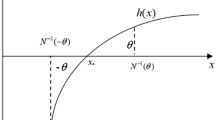Abstract
The qualitative properties of a predatorprey system with Holling-(n + 1) functional response and a fairly general growth rate are completely investigated. The necessary and sufficient condition to guarantee the uniqueness of limit cycles is given. Our work extends the previous relevant results in the reference.
Similar content being viewed by others
References
Volterra, V.: Variazioni e fluttuazioni del numero d'individui in specie animali conviventi. Mem. Res. Com. Tolassogr. Ital., 131, 1–142 (1927)
Freedman, H. I.: Deterministic Mathematical Models in Population Ecology, Marcel Dekker, New York, 1980
Rosenzweig, M. L., MacArthur, R. H.: Graphical representation and stability condition of predator–prey interaction. Am. Nat., 47, 209–223 (1963)
Cheng, K. S.: Uniqueness of a limit cycle for a predator–prey system. SIAM J. Math. Anal., 12, 541–548 (1981)
Kuang, Y., Freedman, H. I.: Uniqueness of limit cycles in Gause type models of predator–prey systems. Math. Biosci., 88, 67–84 (1988)
Chen, J. P., Zhang, H. D.: The qualitative analysis of two species predator–prey model with Holling's type III functional response. Appl. Math. Mech., 7, 77–86 (1986)
Ding, S. H.: On a kind of predator–prey system. SIAM J. Math. Anal., 20(6), 1426–1435 (1989)
Sugie, J., Kohno, R., Miyazaki, R.: On a predator–prey system of Holling type. Proc. A. M. S., 125(7), 2041–2050 (1997)
Kooij, R. E., Zegeling, A.: Qualitative properties of two-dimensional predator–prey systems. Nonlinear Analysis, TMA, 6, 693–715 (1997)
Chen, L. J., Sun, J. H.: On the uniqueness of limit cycle for a class of predator–prey models with Holling functional response. Acta Mathematica Sinica, Chinese Series, 45(2), 383–388 (2002)
Zhang, Z. F.: Proof of the uniqueness theorem of limit cycles of generalized Lienard equation. Appl. Anal., 23, 63–76 (1986)
Author information
Authors and Affiliations
Corresponding author
Additional information
Project supported by the National Natural Science Foundation of China (No. 10171044) and Jiangsu Province (No. BK2001024), and the Foundation for University Key Teachers of the Ministry of Education
Rights and permissions
About this article
Cite this article
Wang, W., Sun, J.H. On the Predator–Prey System with Holling-(n + 1) Functional Response. Acta Math Sinica 23, 1–6 (2007). https://doi.org/10.1007/s10114-005-0603-8
Received:
Accepted:
Published:
Issue Date:
DOI: https://doi.org/10.1007/s10114-005-0603-8



